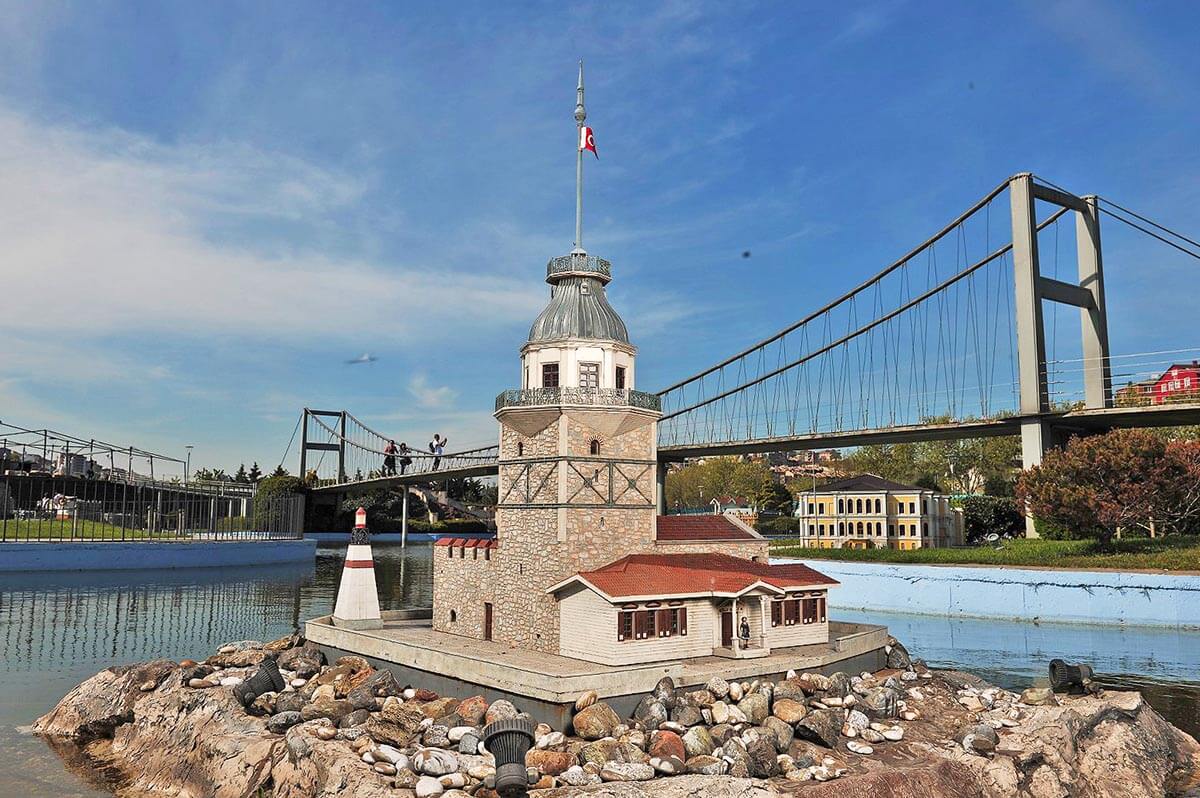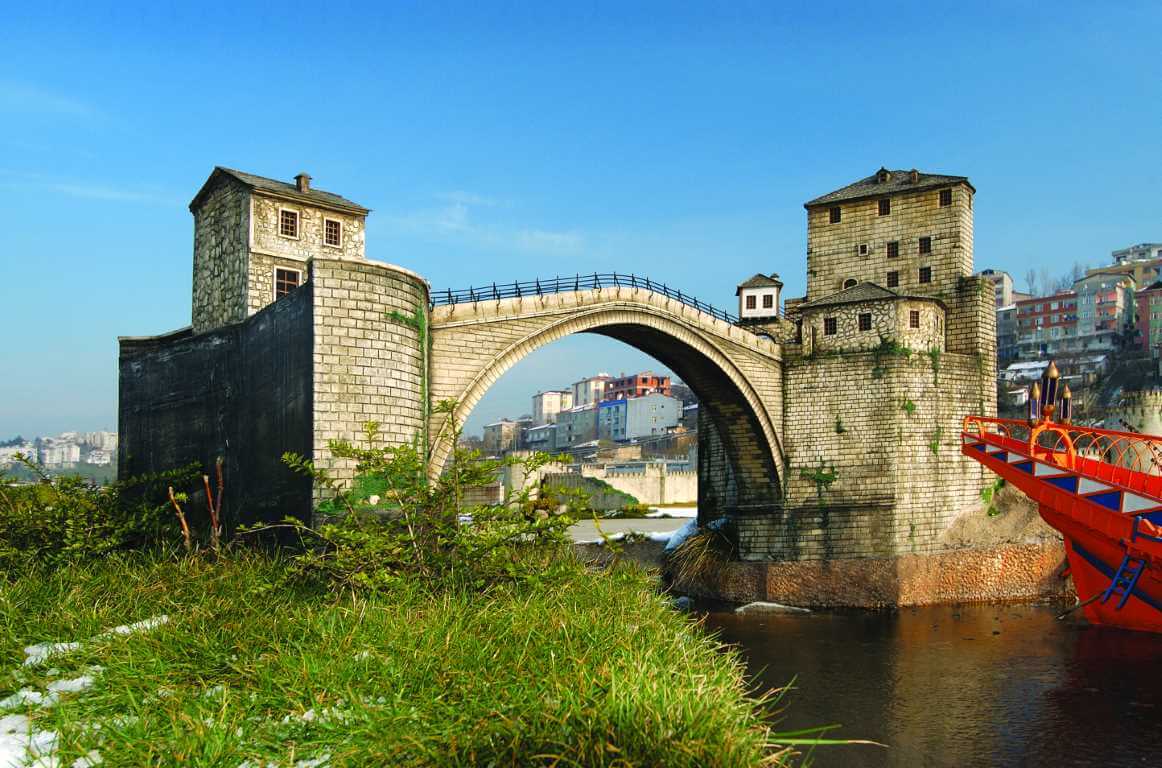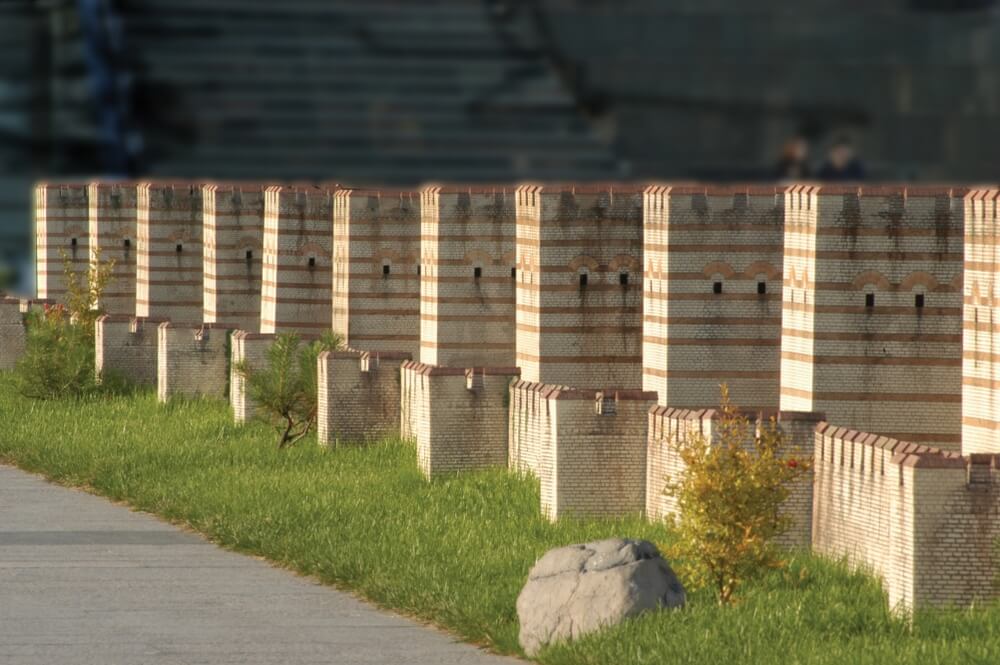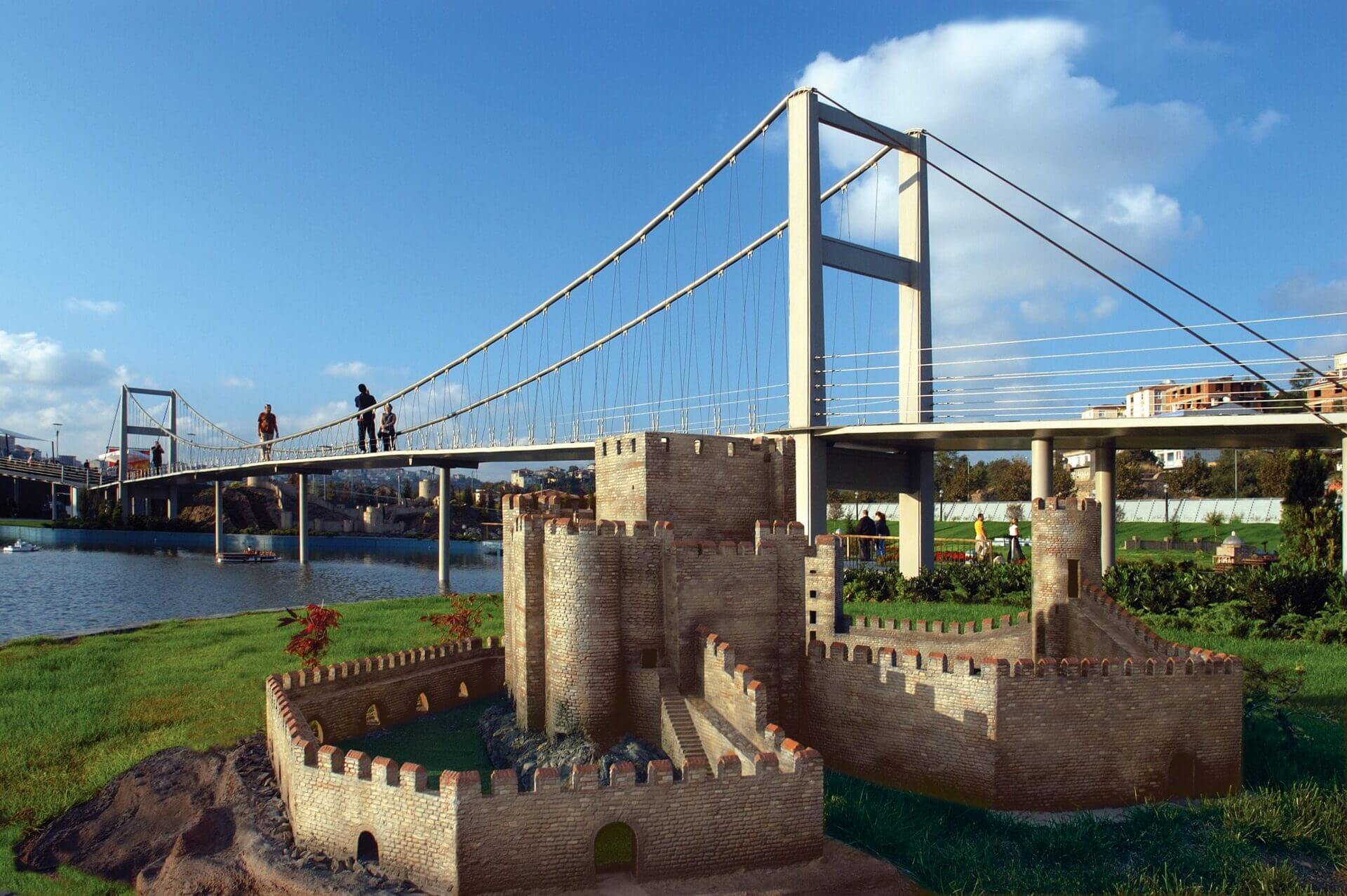Miniatürk Museum History, Exhibits, Entrance Fee, and Visiting Hours
Miniatürk, inaugurated on May 2, 2003, by Istanbul Metropolitan Municipality Cultural Co., is a miniature park in Istanbul, Turkey. It showcases the rich architectural heritage from various civilizations that have ruled these lands, from Ancient Times through the Roman, Byzantine, Seljuk, and Ottoman eras. It’s aptly nicknamed “Turkey’s Showcase” and offers a journey through time with its detailed miniature models.

The park features 139 miniatures at a 1/25 scale, including 62 from Istanbul, 64 from Anatolia, and 13 from regions once part of the Ottoman Empire but now outside Turkey’s borders. These selections were made based on their historical significance and representation of their respective eras.

Miniatürk transcends the confines of Turkish culture alone, reflecting the essence of Anatolia and its neighboring regions. It showcases landmarks like caravanserais, complexes, madrasahs, bridges, stations, docks, fortresses, walls, tombs, mosques, churches, synagogues, palaces, mansions, obelisks, monuments, and statues, as well as unique natural formations like Pamukkale and the Fairy Chimneys. Additionally, models of the Temple of Artemis and the Mausoleum at Halicarnassus, two of the ancient world’s seven wonders, are displayed.

Visitors to Miniatürk can feel as if they have traversed the entire country, from east to west, north to south. The park also offers an Audio Guide Mobile Application service in nine languages, providing information about each model’s original location and significance.

The park spans 60,000 square meters, with 15,000 square meters dedicated to the models. Additional amenities include a 300-vehicle parking lot, restaurants, cafeterias, gift shops, an open-air show area, a children’s playground, ferry, remote-controlled boats, a sightseeing train, a fairy tale tree, a Mini Stadium, chess and labyrinth area, an Upside Down House, and the Miniatek interactive entertainment area with a Turkey-Istanbul simulation helicopter tour.

Miniatürk is a cultural and social responsibility project as much as it is a leisure park. It aims to educate younger generations about the rich civilization they inherit. It has become a must-visit for both domestic and international tourists in Istanbul, offering an immersive and educational Turkish experience.
Transportation to Miniatürk:
- IETT Buses from Eminönü, Mecidiyeköy, Şişli, Taksim, and Topkapı.
- Visitors using the Metrobus can alight at the Halıcıoğlu stop and take a bus or minibus to Miniatürk.
Useful Information:
- The park is wheelchair accessible.
- Facilities include a baby changing unit and wheelchair-accessible restrooms.
- Free wheelchairs are available at the entrance.
- A 300-vehicle parking lot is available for visitors.
Istanbul Model Exhibition:
- A collaboration between İBB Kültür AŞ and ModelPort, this exhibition features over 10,000 figures at a 1/87 scale.
- It represents the historical peninsula of Istanbul, from the 1600s to the 19th century, in a 400,000 m2 area.
- The exhibition, enriched with 50,000 LED lights, brings history to life with dynamic scenes including the Janissary rebellions, horse-drawn carriages, fires, calls to prayer, and the Mehter March.
- Interactive screens provide information in seven languages about the scaled scenes and structures.
Ticket Prices for Miniatürk – Istanbul Model Exhibition:
- Domestic Visitors: 160 TL
- International Visitors: 450 TL
- Domestic Students: 70 TL
- Operating Hours: 10:00 AM – 6:00 PM
Highlighted Miniatures in Miniatürk:
- Yedikule Dungeons: Built by Sultan Mehmed the Conqueror, featuring both Byzantine and Ottoman architectural elements.
- Istanbul Walls: Spanning 21 km, these are among Europe’s longest defensive walls.
- Galatasaray High School: Established in 1481, it has undergone significant reforms since.
- Molla Gürani Mosque (Vefa Kilise Mosque): A 5th-century church converted into a mosque by Molla Gürani.
- Darüşşafaka High School: Designed by Garabet Balyan, this school has been serving talented orphans since its inception in 1868.
- Kariye Mosque (Chora Church): Initially built in 509, converted into a mosque in 1511.
- Galata Tower: Dating back to 1348, originally built by the Genoese.
- Ahrida Synagogue: Built by Jews from Ohri, Macedonia in the 1400s.
- Rumeli Fortress: Constructed by Fatih Sultan Mehmed in 1452 to control the Bosphorus.
- Kalender Passenger Ferry: Served as a museum after its decommissioning in 1981.
- Küçüksu Palace: A Baroque-Rococo style palace built by Sultan Abdülmecid.
- Haydarpaşa Station and Pier: An iconic structure combining various architectural styles.
- Soğukçeşme Street: Known for its historical Istanbul houses with distinctive architectural features.
- Büyük Postane (Grand Post Office): A key example of First National Architectural Movement in Turkey.
- İTÜ Maçka Campus: The former administration building of Maçka Armory, now part of Istanbul Technical University.
- İTÜ Taşkışla Campus: Initially built as a military medical school, now houses İTÜ’s faculties.
- Yerebatan Cistern: A Byzantine-era cistern that provided water to the city.
- III. Ahmed Fountain: Combines Baroque and classical Ottoman styles.
- 15 July Martyrs Bridge (Bosphorus Bridge): The first bridge connecting Asia and Europe in Istanbul.
- Dolmabahçe Clock Tower: Built with Baroque, Neoclassical, and Empire style elements.
- Ertuğrul Frigate: Commissioned by Sultan Abdülaziz, sank in 1890 during a storm off Japan.
- Maiden’s Tower (Kız Kulesi): A historic tower with a 2500-year history.
- Sadullah Paşa Mansion: An example of traditional Turkish residential architecture.
- Northern Sea Area Command Headquarters: Originally commissioned by Fatih Sultan Mehmed.
- Topkapı Palace: The primary residence of Ottoman sultans for centuries.
- Süleymaniye Mosque: A masterpiece of Mimar Sinan, built for Sultan Suleiman the Magnificent.
- Kuleli Military High School: Initially constructed as a barracks, later served as a military high school.
- Eyüp Sultan Mosque: Istanbul’s first mosque, built by Sultan Mehmed II.
- Pertevniyal Valide Sultan Mosque: Unique for its Neo-Gothic style.
- Pertevniyal High School: Established by Pertevniyal Valide Sultan in 1872.
- Hıdiv Kasrı (Khedive’s Palace): Built by Abbas Hilmi Pasha, featuring a blend of Ottoman and European architectural styles.
- Anadolu Hisarı (Anatolian Fortress): One of Istanbul’s oldest Turkish structures, built by Bayezid I.
- Kabataş High School: Established in 1908 on the site of the former Aşiret Mektebi.
- St. Antoine Church: The largest Catholic church in Istanbul, built in the Italian Gothic style.
- Mimar Sinan’s Tomb: The final resting place of the great architect, near Süleymaniye Mosque.
- Walled Column: A 32-meter high column built in the 4th century.
- Serpentine Column: Originally 8 meters high, now stands at 5.5 meters, dating back to the 5th century BCE.
- Egyptian Obelisk: Originally erected in Karnak, brought to Istanbul in 390 CE.
- German Fountain: A gift from German Emperor Wilhelm II to Sultan Abdulhamid II.
- Sultan Ahmed I Tomb: Part of the Sultan Ahmed Mosque complex.
- Aya Irini Church: A Byzantine church, never converted into a mosque.
- Taksim Republic Monument: Built in 1928 by Italian sculptor Pietro Canonica.
- Baştarda 1657: A model of an Ottoman galley, representing the grandeur of the 17th-century navy.
Miniatürk: Anadolu Artifacts
- Trabzon Sumela Monastery: Known as the Virgin Mary Monastery, built into a mountain cliff around 385 AD by two monks from Athens. It’s about 400 square meters in size and is accessed by a steep, narrow 100-step staircase.
- Amasya Yaliboyu Houses: These houses along the Yeşilırmak River in Amasya were built at the end of the 19th and beginning of the 20th century. They are known as one of Anatolia’s first prefabricated homes.
- Anıtkabir: Located in Ankara, this is the mausoleum of Mustafa Kemal Atatürk, founder of the Turkish Republic. Completed in nine years, from 1944 to 1953, it’s considered one of Turkey’s most significant structures.
- Selimiye Mosque: This grand Ottoman structure in Edirne was built for Sultan Selim II between 1568 and 1575. Designed by Mimar Sinan, it’s renowned for its four minarets and architectural grandeur.
- Aspendos: A 2nd-century AD theater in Antalya’s ancient city of Aspendos, known for its 15,000-person capacity and preservation.
- Sivas Divriği Ulu Mosque: Constructed in 1229 in Sivas, this mosque is known for its intricately carved portal and geometric and floral motifs.
- Zeus Altar: Built between 197 and 159 BC in the ancient city of Pergamon in İzmir. Known for its Ionic columns and Hellenistic sculpture, it’s a notable example of the Pergamon school of sculpture.
- Ephesus Celsus Library: Located in Selçuk, İzmir, built between 115-117 AD during the Roman period. The façade was restored after being damaged in 3rd-century earthquakes.
- Hittite Civilization: Features the Sphinx Gate, Yazılıkaya Temple, and Hittite Walls from Hattuşa. The walls date back to the 14th century BC and helped the Hittites maintain their presence in the region.
- Sivas Gök Medrese: A symbolic structure of Sivas, built in 1271 by the Seljuk Vizier Sahip Ata. Known for its twin minaret and ornate stonework featuring animal heads, stars, and the tree of life motifs.
- Karaman Hatuniye Madrasah: Built in 1382, this madrasah is a notable example of the Karamanoğulları period, known for its cut stone structure and white marble portal.
- Konya Karatay Madrasah: Erected in 1251 by the Seljuk Vizier Karatay. Known for its blue and white marble inscriptions and designs, it now serves as a Tile Artifacts Museum.
- Ertuğrul Gazi Tomb: The tomb of Ertuğrul Gazi, father of Osman Gazi and founder of the Ottoman Empire, located in Bilecik, within the Söğüt district.
- Temple of Artemis: One of the Ancient World’s Seven Wonders, located in Ephesus, Selçuk, İzmir. Built between 334-320 BC, it was the largest Hellenistic temple.
- Çanakkale Martyrs’ Memorial: Built in memory of the 250,000 soldiers who perished in Çanakkale. Construction began in 1954 and was completed in 6.5 years.
- Mausoleum of Halicarnassus: Another of the Ancient World’s Seven Wonders, built in the 4th century BC for Mausolus, a Persian Satrap.
- İzmir Clock Tower: Built in 1901 by Grand Vizier Küçük Said Pasha as a 25th-anniversary gift for Sultan Abdulhamid II. The clock was a gift from German Emperor Wilhelm.
- Malabadi Bridge: Located near Diyarbakır, Silvan, it’s the world’s widest arched stone bridge, built in 1147 by Timurtash of Artuqid dynasty.
- Nemrut Mountain Remains: Located in Adıyaman, Kahta, these are remnants of the Commagene Kingdom, dating back to 80 BC – 72 AD.
- Safranbolu Houses: These 18th-century houses in Safranbolu are renowned for their architecture, characterized by stone ground floors and quality wooden upper floors.
- Virgin Mary Church: Located in İzmir, originally built as a marketplace in the Roman era, later converted into a church with only the apse remaining today.
- Manisa Muradiye Mosque: Constructed between 1583-1586 by Ottoman Sultan Murad III in Manisa. Known for its intricately carved wooden entrance.
- Konya Alaeddin Mosque: An early Seljuk structure in Konya, built starting in 1155 and completed in 1200. It represents old Arabic style with multiple columns.
- Konya Ince Minaret Madrasah: Built between 1260-1264 by Seljuk Vizier Sahip Ata. Famous for its tiled minaret and carved stone doorway.
- Erzurum Double Minaret Madrasah: Believed to be built by the daughter of Seljuk Sultan I. Alaeddin Keykubad between 1270-1291. Converted into a museum in 1942.
- Mevlana Tomb: Completed in 1274 in Konya, known for its turquoise tiled dome. The tomb has been a museum since 1927.
- TBMM Parliament Building: Designed by Austrian architect Clemens Holzmeister, the building was inaugurated on January 6, 1961.
- Ishak Pasha Palace: Built in 1784 near Doğubeyazıt, this palace covers 7600 square meters and combines Ottoman palace design with Seljuk portal architecture.
- TC Ziraat Bank: Built between 1926-1929 by Italian architect Giulio Mongeri, this building is a prime example of the First National Architectural Movement.
- Hacı Bayram Mosque: Built in 1427 in Ankara, dedicated to the mystic and poet Hacı Bayram Veli. The mosque and tomb underwent restoration by Mimar Sinan in the 16th century.
- Augustus Temple: Built in Ankara during 25-20 BC by Emperor Augustus on the site of a sanctuary dedicated to Kybele and Men. It was later used as a church by the Byzantines.
- Antalya Yivli Minaret Mosque: Constructed in 1230 by Seljuk Sultan Alaeddin Keykubat, known for its fluted minaret standing on a square base.
- Mersin Maiden’s Castle (Kız Kalesi): Built in the 4th century BC, it has been under various dominions, including the Seleucids, Romans, Byzantines, Seljuks, Armenians, French (Cyprus Kingdom), Karamanoğulları, and Ottomans.
- Zeynel Bey Tomb and Complex: Built between 1462-1482 for Zeynel Bey, who died in the Battle of Otlukbeli, by his father, Uzun Hasan, ruler of Akkoyunlu.
- Adana Stone Bridge: Constructed in the 2nd century by Roman Emperor Hadrianus, it’s one of the key ancient bridges linking trade routes.
- Kırşehir Aşık Paşa Tomb: Built in 1322, it’s a work from the Eretna Beylik period. Known for its carved stone architecture and oyster shell-shaped portal.
- Emir Bayındır Tomb & Ahlat Seljuk Cemetery: An Akkoyunlu era structure built for Emir Bayındır, grandson of Uzun Hasan, by his wife Şah Selime Hatun in 1481.
- Halilürrahman Mosque and Fish Lake: Located in Şanlıurfa, built from cut stone in 1211. The mosque and the adjacent sacred Fish Lake (Ayn-ı Zeliha) are important religious sites.
- Diyarbakır Great Mosque: The oldest mosque in Anatolia, it has undergone renovations throughout the Seljuk, Artuklu, Akkoyunlu, Karakoyunlu, and Ottoman periods.
- Bursa Green Tomb: Constructed in 1421 next to the Yeşil Mosque in Bursa. The tomb, containing 8 sarcophagi, is famous for its intricate designs.
- Bursa Grand Mosque: The largest mosque in Bursa, opened in 1400. Built by Bayezid I following the victory at Niğbolu, it’s known for its walnut-carved pulpit and calligraphy.
- Somuncu Baba Complex (1640): Built in Darende for the mystic Somuncu Baba, who was known for distributing free bread in Bursa. The complex includes a tomb, a mosque, and a natural spring.
- Selçuk İsa Bey Mosque: Located between the Temple of Artemis and the Saint Jean Christian church in Selçuk, this mosque was built in 1375 by Aydınoğlu İsa Bey. Designed by architect Şamlı Ali, it features two entrances, one on the east and one on the west. The west entrance is decorated with inscriptions and geometric shapes.
- İsmail Fakirullah and İbrahim Hakkı Hazretleri Tomb: İbrahim Hakkı Hazretleri constructed this tomb for his teacher and wished to be buried at its foot. The tomb consists of two small domed rooms, a hall, and an eight-sided, 10-meter high tower.
- Giresun Water Mill, Dibek Stone, and Serender: These are distinctive architectural structures found in Giresun’s rural areas. Serenders serve as storage for agricultural and livestock-based rural life. Water mills are key for grinding wheat or corn into flour, often a communal property in villages. The Dibek Stone, or hand mill, is used for grinding corn or wheat into bulgur, operated manually.
- Rize Water Mill, Dibek Stone, and Serender (Nayla): In Rize, serenders (also known as naylas) are typical architectural elements used for storing and drying food, particularly grains. Water mills were primarily used for grinding corn, typically located near streams or rivers. The Dibek Stone is used for separating the bran from wheat or corn.
- Rize Kıbledağı Dua Tepesi Yusuf Hoca Mosque: Initially built in the 1800s in wood on Rize’s Güneysu district’s Kıbledağı (1130 meters high), it was destroyed in a fire in 1960 and rebuilt by Hafız Yusuf Yılmaz Hocaefendi. It was reconstructed in Ottoman architecture under the patronage of President Recep Tayyip Erdoğan in 2015.
- Şebinkarahisar Independence Fountain: Built in 1927 by Mayor Hüsnü Bey in Giresun Şebinkarahisar in memory of the National Struggle and the founding of the Republic. Originally constructed in front of the old municipal building, it was moved to the city square in 1985, and a roof was added afterwards.
- Kocatepe Atatürk Monument: Created by the painter and sculptor Senan Eynullayev, this monument is dedicated to Atatürk.
- Ahi Evran Mosque and Tomb: Located in the city center of Kırşehir, this complex was built in 1482 in honor of Ahi Evran-ı Veli, the founder of the Ahilik organization. The historical site was added to UNESCO’s Tentative List of World Heritage in 2014.
Miniatürk: International Artifacts
- Gazi Ali Paşa Tomb in Romania: Built in the 17th century, this tomb within the borders of modern-day Romania is a significant Turkish artifact. Its hexagonal dome is uniquely covered with asphalt and sprinkled with pebbles, a style found only in Romania.
- Sultan Murad Tomb in Kosovo: The oldest Ottoman architectural work in Kosovo, this 14th-century tomb is a symbol of Turkish and Islamic presence in the region. Although Sultan Murad Hüdavendigar, who died in the Battle of Kosovo, was buried in Bursa, his son Bayezid built a tomb in Kosovo in his memory.
- Gül Baba Tomb in Budapest: The tomb of the Bektashi dervish Cafer, also known as Gül Dede, who died during the siege of Buda Castle. Built in the 16th century in Budapest, the tomb is an important Turkish structure in the Balkans.
- Al-Aqsa Mosque: Located in Jerusalem, Al-Aqsa Mosque, Islam’s first qibla, was built in the 6th century. It acquired its current form following maintenance and repairs by the Ottomans after Sultan Selim I’s conquest in 1517, and further renovations by Architect Kemaleddin Bey in the early 20th century.
- Jerusalem Sultan Suleiman Walls Damascus Gate: One of the seven gates in the 4-kilometer-long walls surrounding Jerusalem, the Damascus Gate and the Suleiman Walls were built in 1542 by Suleiman the Magnificent, and are still referred to by his name.
- Hamidiye Clock Tower: Built in 1901 by Sultan Abdul Hamid II to commemorate his 25th anniversary on the throne, the Hamidiye Clock Tower is both a symbol of the city of Tripoli and one of the most significant Ottoman structures in Lebanon. The tower, standing at 26 meters with six levels, features walls made of sandy stone, and white stone for the corners, windows, and doors.
- Damascus Station: The Damascus station, a stop of the historic Hejaz Railway, was built in 1911 and stands in all its glory to this day.
- Mehmed Ali Pasha Mosque: Construction began in 1830 during the reign of Mehmet Ali Pasha and was completed in 1848 under the rule of Abbas Hilmi Pasha. Designed by the Bosnian architect Yusuf, like all of Mehmed Ali Pasha’s constructions in Cairo, it reflects the Baroque and Rococo styles of the 18th century.
- Ecyad Castle: Located in Mecca, Ecyad Castle was built at the end of the 16th century to aid in the defense of the Kaaba and was used as a Turkish garrison until World War I. Its demolition on January 3, 2002, left only the arcades around the Kaaba, built under Sultan Selim II and designed by Mimar Sinan, as the remaining evidence of centuries of Turkish rule in Mecca.
- Mostar Bridge: Constructed in 1566-67 by Mimar Hayreddin, a student of Mimar Sinan, this bridge in Mostar became a symbol of the city and one of the world’s largest single-arch stone bridges. It was destroyed during the war in 1993 and rebuilt and reopened in 2003.
- Dome of the Rock (Kubbetü’s-Sahra): Built in 691 by Caliph Abdul Malik bin Marwan, the Dome of the Rock is one of the leading works in Islamic architectural history. The lower part of the structure in Jerusalem is marble, while the upper part is covered with green, yellow, and blue tiles, restored during the reign of Suleiman the Magnificent.
- Atatürk’s House: The house in Thessaloniki where Mustafa Kemal Atatürk, the founder of the Republic of Turkey, was born and where his family lived for many years, was built in 1870. It is located in the garden of the Turkish Consulate General in Thessaloniki.
Transport Information
Easiest ways to reach Miniatürk.
İETT Lines
Eminönü: Municipal Bus Lines 47, 47Ç, 47E and 47N
Mecidiyeköy and Şişli: Municipal Bus Line 54 HŞ (Hasköy/Şişli)
Taksim: Municipal Bus Line 36 T (Cebeci- Taksim)
Topkapı: Municipal Bus Line 41 ST (Seyrantepe-Topkapı)
Sultanahmet- Dolmabahçe: Municipal Bus Line TB 1
Click here for detailed information about the lines and their timetables from IETT’s web page. Click
Seyrantepe / Topkapı minibuses
Metrobus (BRT)
Visitors coming with the Metrobus can change at Halıcıoğlu station to take the bus line 41 ST or minibus and access to Miniatürk.
Adress
Örnektepe Mahallesi, İmrahor Caddesi,No.7 Sütlüce 34445 Beyoğlu – İstanbul
Phone
+90 212 222 28 82




Looking at the visitor reviews of Miniatürk, the feedback is predominantly positive. Many visitors highlight the park as an interesting and educational experience, particularly enjoyable for children. The staff is often commended for being polite and helpful, and the park’s cleanliness and orderliness are frequently mentioned.
However, there are some critiques as well. Some visitors suggest that the park needs maintenance and updates, with better preservation of certain activities and miniatures. The high cost of entry and additional activities is also pointed out in some comments.
Overall, it appears that Miniatürk is considered by visitors as an enjoyable experience, offering a great opportunity to see miniatures of structures from various parts of Turkey.